The other day someone on this board asked for ideas for what to do over the Easter break, one of the things I suggested was to do a tutorial on something that they were particularly skilled at. That got me thinking, what was the one skill I was particularly happy I had learnt, and was quite good at?
Here is the result
Tadpoles Char-cloth tutorial
Pictures by H (my daughter)
Pre-ramble
The whole point of char-cloth is that it is, or should be, easy to light, even with the slightest of sparks, until I hit on this method I found my experiences with the char cloth, very unsatisfactory. For the most part I found that unless you hit a lucky spark, one that hit the frayed edge, The char-cloth it was very unlikely to light. Ive used denim, tea-towel, and tee-shirts galore. In fact lots of thing and all were unsuccessful, in that it involved a lot of striking of the flint/ferro rod, to get any result.
Being a bit tight with the old-cash and having ran out of char-cloth, the only thing I had spare was a used dish-cloth. After putting it through a wash in the dishwasher (hell it was on and I for one was not willing to risk the wrath of SHMBO by putting it in with my whites. Ive never looked back. This method is (in my opinion) the most successful. (A single un-noticed stray spark landing in the tin I keep my cloth in, with in a few moments the whole lot was gone.)
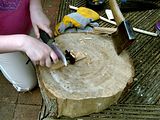
First you need fire; my daughter here is demonstrating the ease is which it will take a spark. Four minutes after this picture was taken the fire was lit and the kettle was on

Two sparks from the same stroke strike the cloth and both start to smoulder
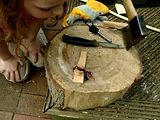
Blowing on the cloth for a few second and most of it was glowing red
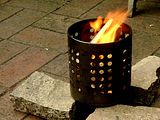
The Hobo at full go with enough wood to boil the kettle (1.5lt water) the whole family was pottering in the garden, (thirsty work this pottering)
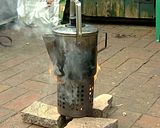
My hobo without the windshield (not made one yet)
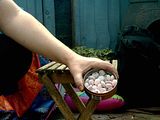
For my char cloth retort I use a travel sweet tin purchased from Aldi, they are on offer at the moment at 75p and are full of sweets. Its up to you what you do with them
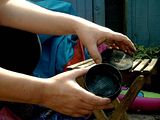
I prefer to burn off the paint, before I use the tin. This tin is one that I have used before, the hole in the top is slightly larger than Id normally use, I try and start with a smallish hole, as with use it will get bigger. I start the hole with the tip of my knife and push a sharpened twig into the hole to enlarge it. This hole is there to allow the gas to escape, and prevents a build up of pressure which would pop the lid right of the tin, with amusing results,
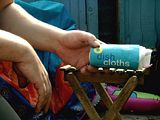
For this batch of char-cloth I used new dish-cloths (I dont know what happened to the last lot ) again Aldi comes in handy as they sell a packet of 8 cloths for 76p.
) again Aldi comes in handy as they sell a packet of 8 cloths for 76p.
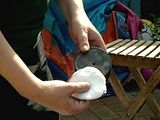
I cut my dish cloths to fit the tin. From one pack of dish cloths you can make 32 round double thickness disks of char-cloth, and one tin full of off cuts (great for using with a flint and steel) it doesnt matter how you do it so long as the lid of the tin shuts and stays shut.
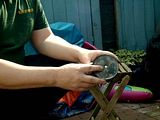
Here I'm pointing out the very important hole.
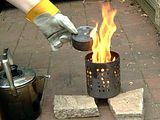
Here for effect Ive added a bit more wood (mainly to level the bed of the fire so the next two pictures could be taken
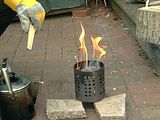
It is hard to see, but after about five minutes the cloth in the tin starts to cook/char and any gas forced out of the hole starts to burn
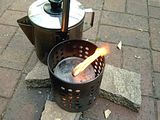
This picture shows the effect of the gasing off, I do not do anything more to eith the fire or the tin until the flames have stopped completely.
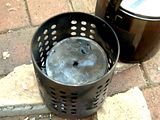
Just as the very last wisp of flame dies, taken just before I block the hole
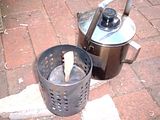
As soon as the flames go out I block the hole in the tin with a piece of wood, and let the whole lot bake on the fire for quarter of an hour. The whole process from putting the tin in the fire takes about 40 minutes. After leaving the tin to cool I remove it from the fire, and open it to see if all the cloth has all charred, if not I return it to the fire for a bit longer.
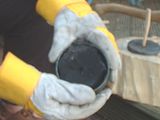
In this picture you can just about see just how much the cloth shrinks as it is cooked. The tin was packed tightly, yet there is now half an inch gap all around the charred cloth.
I think thatthe reason that charcloth made from dish cloth works so well, is the weave of the cloth is loose; there are lots of gaps in the cloth for the spark to catch and hold.
Sorry about the quality of the last picture I was forced to change camera as the one I was using was full. For some reason this camera insisted on flashing every time and not focusing
Hope this is of some use to someone
Here is the result
Tadpoles Char-cloth tutorial
Pictures by H (my daughter)
Pre-ramble
The whole point of char-cloth is that it is, or should be, easy to light, even with the slightest of sparks, until I hit on this method I found my experiences with the char cloth, very unsatisfactory. For the most part I found that unless you hit a lucky spark, one that hit the frayed edge, The char-cloth it was very unlikely to light. Ive used denim, tea-towel, and tee-shirts galore. In fact lots of thing and all were unsuccessful, in that it involved a lot of striking of the flint/ferro rod, to get any result.
Being a bit tight with the old-cash and having ran out of char-cloth, the only thing I had spare was a used dish-cloth. After putting it through a wash in the dishwasher (hell it was on and I for one was not willing to risk the wrath of SHMBO by putting it in with my whites. Ive never looked back. This method is (in my opinion) the most successful. (A single un-noticed stray spark landing in the tin I keep my cloth in, with in a few moments the whole lot was gone.)

First you need fire; my daughter here is demonstrating the ease is which it will take a spark. Four minutes after this picture was taken the fire was lit and the kettle was on

Two sparks from the same stroke strike the cloth and both start to smoulder

Blowing on the cloth for a few second and most of it was glowing red

The Hobo at full go with enough wood to boil the kettle (1.5lt water) the whole family was pottering in the garden, (thirsty work this pottering)

My hobo without the windshield (not made one yet)

For my char cloth retort I use a travel sweet tin purchased from Aldi, they are on offer at the moment at 75p and are full of sweets. Its up to you what you do with them

I prefer to burn off the paint, before I use the tin. This tin is one that I have used before, the hole in the top is slightly larger than Id normally use, I try and start with a smallish hole, as with use it will get bigger. I start the hole with the tip of my knife and push a sharpened twig into the hole to enlarge it. This hole is there to allow the gas to escape, and prevents a build up of pressure which would pop the lid right of the tin, with amusing results,

For this batch of char-cloth I used new dish-cloths (I dont know what happened to the last lot

I cut my dish cloths to fit the tin. From one pack of dish cloths you can make 32 round double thickness disks of char-cloth, and one tin full of off cuts (great for using with a flint and steel) it doesnt matter how you do it so long as the lid of the tin shuts and stays shut.

Here I'm pointing out the very important hole.

Here for effect Ive added a bit more wood (mainly to level the bed of the fire so the next two pictures could be taken

It is hard to see, but after about five minutes the cloth in the tin starts to cook/char and any gas forced out of the hole starts to burn

This picture shows the effect of the gasing off, I do not do anything more to eith the fire or the tin until the flames have stopped completely.

Just as the very last wisp of flame dies, taken just before I block the hole

As soon as the flames go out I block the hole in the tin with a piece of wood, and let the whole lot bake on the fire for quarter of an hour. The whole process from putting the tin in the fire takes about 40 minutes. After leaving the tin to cool I remove it from the fire, and open it to see if all the cloth has all charred, if not I return it to the fire for a bit longer.

In this picture you can just about see just how much the cloth shrinks as it is cooked. The tin was packed tightly, yet there is now half an inch gap all around the charred cloth.
I think thatthe reason that charcloth made from dish cloth works so well, is the weave of the cloth is loose; there are lots of gaps in the cloth for the spark to catch and hold.
Sorry about the quality of the last picture I was forced to change camera as the one I was using was full. For some reason this camera insisted on flashing every time and not focusing
Hope this is of some use to someone




